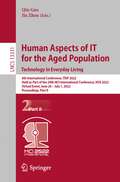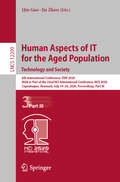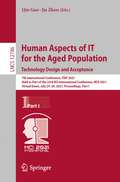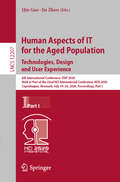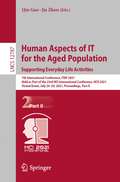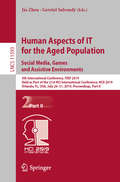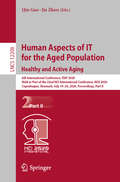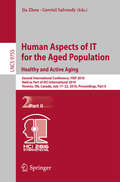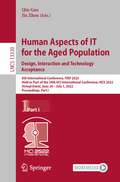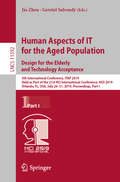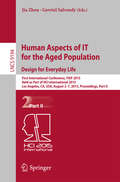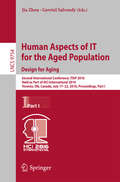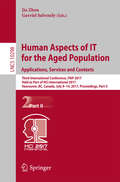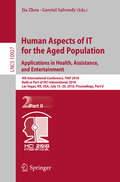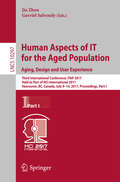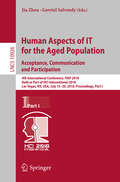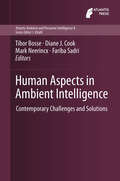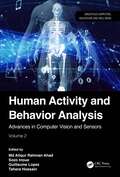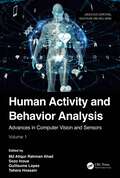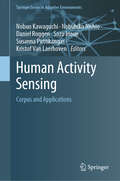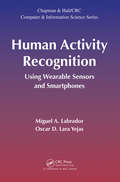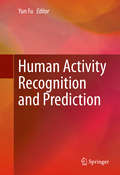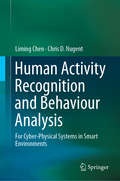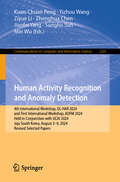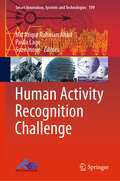- Table View
- List View
Human Aspects of IT for the Aged Population. Technology in Everyday Living: 8th International Conference, ITAP 2022, Held as Part of the 24th HCI International Conference, HCII 2022, Virtual Event, June 26 – July 1, 2022, Proceedings, Part II (Lecture Notes in Computer Science #13331)
by Jia Zhou Qin GaoThis two-volume set constitutes the refereed proceedings of the 8th International Conference on Human Aspects of IT for the Aged Population, ITAP 2022, held as part of the 24th International Conference, HCI International 2022, held as a virtual event, during June-July 2022. ITAP 2022 includes a total of 75 papers, which focus on topics related to designing for and with older users, technology acceptance and user experience of older users, use of social media and games by the aging population, as well as applications supporting health, wellbeing, communication, social participation and everyday activities. The papers are divided into the following topical sub-headings. Part I: Aging, Design and Gamification; Mobile, Wearable and Multimodal Interaction for Aging; Aging, Social Media and Digital Literacy; and Technology Acceptance and Adoption: Barriers and Facilitators for Older Adults Part II: Intelligent Environment for Daily Activities Support; Health and Wellbeing Technologies for the Elderly; and Aging, Communication and Social Interaction.
Human Aspects of IT for the Aged Population. Technology and Society: 6th International Conference, ITAP 2020, Held as Part of the 22nd HCI International Conference, HCII 2020, Copenhagen, Denmark, July 19–24, 2020, Proceedings, Part III (Lecture Notes in Computer Science #12209)
by Jia Zhou Qin GaoThis three volume set of LNCS 12207, 12208 and 12209 constitutes the refereed proceedings of the 6th International Conference on Human Aspects of IT for the Aged Population, ITAP 2020, held as part of the 22nd International Conference, HCI International 2020, which took place in Copenhagen, Denmark, in July 2020. The conference was held virtually due to the COVID-19 pandemic. The total of 1439 papers and 238 posters have been accepted for publication in the HCII 2020 proceedings from a total of 6326 submissions. ITAP 2020 includes a total of 104 regular papers which are organized in topical sections named: Involving Older Adults in HCI Methodology , User Experience and Aging, Aging and Mobile and Wearable Devices, Health and Rehabilitation Technologies, Well-being, Persuasion, Health Education and Cognitive Support, Aging in Place, Cultural and Entertainment Experiences for Older Adults, Aging and Social Media, Technology Acceptance and Societal Impact.
Human Aspects of IT for the Aged Population. Technology Design and Acceptance: 7th International Conference, ITAP 2021, Held as Part of the 23rd HCI International Conference, HCII 2021, Virtual Event, July 24–29, 2021, Proceedings, Part I (Lecture Notes in Computer Science #12786)
by Jia Zhou Qin GaoThis two-volume set constitutes the proceedings of the 7th International Conference on Human Aspects of IT for the Aged Population, ITAP 2021, held as part of the 23rd International Conference, HCI International 2021, held as a virtual event, in July 2021. The total of 1276 papers and 241 posters included in the 36 HCII 2021 proceedings volumes was carefully reviewed and selected from 5222 submissions. ITAP 2021 includes a total of 67 regular papers; they focus on topics related to designing for and with older users, technology acceptance and user experience of older users, use of social media and games by the aging population, as well as applications supporting health, wellbeing, communication, social participation and everyday activities.
Human Aspects of IT for the Aged Population. Technologies, Design and User Experience: 6th International Conference, ITAP 2020, Held as Part of the 22nd HCI International Conference, HCII 2020, Copenhagen, Denmark, July 19–24, 2020, Proceedings, Part I (Lecture Notes in Computer Science #12207)
by Jia Zhou Qin GaoThis three volume set of LNCS 12207, 12208 and 12209 constitutes the refereed proceedings of the 6th International Conference on Human Aspects of IT for the Aged Population, ITAP 2020, held as part of the 22nd International Conference, HCI International 2020, which took place in Copenhagen, Denmark, in July 2020. The conference was held virtually due to the COVID-19 pandemic. The total of 1439 papers and 238 posters have been accepted for publication in the HCII 2020 proceedings from a total of 6326 submissions. ITAP 2020 includes a total of 104 regular papers which are organized in topical sections named: Involving Older Adults in HCI Methodology , User Experience and Aging, Aging and Mobile and Wearable Devices, Health and Rehabilitation Technologies, Well-being, Persuasion, Health Education and Cognitive Support, Aging in Place, Cultural and Entertainment Experiences for Older Adults, Aging and Social Media, Technology Acceptance and Societal Impact.
Human Aspects of IT for the Aged Population. Supporting Everyday Life Activities: 7th International Conference, ITAP 2021, Held as Part of the 23rd HCI International Conference, HCII 2021, Virtual Event, July 24–29, 2021, Proceedings, Part II (Lecture Notes in Computer Science #12787)
by Jia Zhou Qin GaoThis two-volume set constitutes the proceedings of the 7th International Conference on Human Aspects of IT for the Aged Population, ITAP 2021, held as part of the 23rd International Conference, HCI International 2021, held as a virtual event, in July 2021. The total of 1276 papers and 241 posters included in the 36 HCII 2021 proceedings volumes was carefully reviewed and selected from 5222 submissions. ITAP 2021 includes a total of 67 regular papers; they focus on topics related to designing for and with older users, technology acceptance and user experience of older users, use of social media and games by the aging population, as well as applications supporting health, wellbeing, communication, social participation and everyday activities.
Human Aspects of IT for the Aged Population. Social Media, Games and Assistive Environments: 5th International Conference, ITAP 2019, Held as Part of the 21st HCI International Conference, HCII 2019, Orlando, FL, USA, July 26-31, 2019, Proceedings, Part II (Lecture Notes in Computer Science #11593)
by Gavriel Salvendy Jia ZhouThis two-volume set LNCS 11592 and 11593 constitutes the refereed proceedings of the 5th International Conference on Human Aspects of IT for the Aged Population, ITAP 2019, held in July 2019 as part of HCI International 2019 in Orlando, FL, USA. HCII 2019 received a total of 5029 submissions, of which 1275 papers and 209 posters were accepted for publication after a careful reviewing process. The 86 papers presented in these two volumes are organized in topical sections named: Design with and for the Elderly, Aging and Technology Acceptance, Aging and the User Experience, Elderly-Specific Web Design, Aging and Social Media, Games and Exergames for the Elderly, Ambient Assisted Living, Aging, Motion, Cognition, Emotion and Learning.
Human Aspects of IT for the Aged Population. Healthy and Active Aging: 6th International Conference, ITAP 2020, Held as Part of the 22nd HCI International Conference, HCII 2020, Copenhagen, Denmark, July 19–24, 2020, Proceedings, Part II (Lecture Notes in Computer Science #12208)
by Jia Zhou Qin GaoThis three volume set of LNCS 12207, 12208 and 12209 constitutes the refereed proceedings of the 6th International Conference on Human Aspects of IT for the Aged Population, ITAP 2020, held as part of the 22nd International Conference, HCI International 2020, which took place in Copenhagen, Denmark, in July 2020. The conference was held virtually due to the COVID-19 pandemic. The total of 1439 papers and 238 posters have been accepted for publication in the HCII 2020 proceedings from a total of 6326 submissions. ITAP 2020 includes a total of 104 regular papers which are organized in topical sections named: Involving Older Adults in HCI Methodology , User Experience and Aging, Aging and Mobile and Wearable Devices, Health and Rehabilitation Technologies, Well-being, Persuasion, Health Education and Cognitive Support, Aging in Place, Cultural and Entertainment Experiences for Older Adults, Aging and Social Media, Technology Acceptance and Societal Impact.
Human Aspects of IT for the Aged Population. Healthy and Active Aging
by Gavriel Salvendy Jia ZhouThe two LNCS volume set 9754-9755 constitutes the refereed proceedings of the Second International Conference on Human Aspects of IT for the Aged Population, ITAP 2016, held as part of the 18th International Conference on Human-Computer Interaction, HCII 2016, held in Toronto, ON, Canada, in July 2016, jointly with 14 other thematically conferences. The total of 1287 papers presented at the HCII 2016 conferences were carefully reviewed and selected from 4354 submissions. LNCS 9754, Design for Aging (Part I), addresses the following major topics: designing for and with the elderly; technology use and acceptance by older users; psychological and cognitive aspects of interaction and aging; and mobile and wearable technologies for the elderly. LNCS 9755, Healthy and Active Aging (Part II), addresses these major topics: smart and assistive environments; aging and social media; aging, learning, training and games; and aging, mobility and driving.
Human Aspects of IT for the Aged Population. Design, Interaction and Technology Acceptance: 8th International Conference, ITAP 2022, Held as Part of the 24th HCI International Conference, HCII 2022, Virtual Event, June 26 – July 1, 2022, Proceedings, Part I (Lecture Notes in Computer Science #13330)
by Jia Zhou Qin GaoThis two-volume set constitutes the refereed proceedings of the 8th International Conference on Human Aspects of IT for the Aged Population, ITAP 2022, held as part of the 24th International Conference, HCI International 2022, held as a virtual event, during June-July 2022. ITAP 2022 includes a total of 75 papers, which focus on topics related to designing for and with older users, technology acceptance and user experience of older users, use of social media and games by the aging population, as well as applications supporting health, wellbeing, communication, social participation and everyday activities. The papers are divided into the following topical sub-headings. Part I: Aging, Design and Gamification; Mobile, Wearable and Multimodal Interaction for Aging; Aging, Social Media and Digital Literacy; and Technology Acceptance and Adoption: Barriers and Facilitators for Older Adults Part II: Intelligent Environment for Daily Activities Support; Health and Wellbeing Technologies for the Elderly; and Aging, Communication and Social Interaction.
Human Aspects of IT for the Aged Population. Design for the Elderly and Technology Acceptance: 5th International Conference, ITAP 2019, Held as Part of the 21st HCI International Conference, HCII 2019, Orlando, FL, USA, July 26-31, 2019, Proceedings, Part I (Lecture Notes in Computer Science #11592)
by Gavriel Salvendy Jia ZhouThis two-volume set LNCS 11592 and 11593 constitutes the refereed proceedings of the 5th International Conference on Human Aspects of IT for the Aged Population, ITAP 2019, held in July 2019 as part of HCI International 2019 in Orlando, FL, USA. HCII 2019 received a total of 5029 submissions, of which 1275 papers and 209 posters were accepted for publication after a careful reviewing process. The 86 papers presented in these two volumes are organized in topical sections named: Design with and for the Elderly, Aging and Technology Acceptance, Aging and the User Experience, Elderly-Specific Web Design, Aging and Social Media, Games and Exergames for the Elderly, Ambient Assisted Living, Aging, Motion, Cognition, Emotion and Learning.
Human Aspects of IT for the Aged Population. Design for Everyday Life
by Gavriel Salvendy Jia ZhouThe two LNCS volume set 9193-9194 constitutes the refereed proceedings of the First International Conference on Human Aspects of IT for the Aged Population, ITAP 2015, held as part of the 17th International Conference on Human-Computer Interaction, HCII 2015, held in Los Angeles, CA, USA, in August 2015, jointly with 15 other thematically conferences. The total of 1462 papers and 246 posters presented at the HCII 2015 conferences were carefully reviewed and selected from 4843 submissions. These papers of the two volume set address as follows: LNCS 9193, Design for Aging (Part I), addressing the following major topics: HCI design and evaluation methods for the elderly; ICT use and acceptance; aging, the web and social media; and the elderly and mobile devices and LNCS 9194, Design for Everyday Life (Part II), addressing the following major topics: health care technologies and services for the elderly; home and work support; smart environment and AAL; and communication, games, and entertainment.
Human Aspects of IT for the Aged Population. Design for Aging
by Gavriel Salvendy Jia ZhouThe two LNCS volume set 9193-9194 constitutes the refereed proceedings of the First International Conference on Human Aspects of IT for the Aged Population, ITAP 2015, held as part of the 17th International Conference on Human-Computer Interaction, HCII 2015, held in Los Angeles, CA, USA, in August 2015, jointly with 15 other thematically conferences. The total of 1462 papers and 246 posters presented at the HCII 2015 conferences were carefully reviewed and selected from 4843 submissions. These papers of the two volume set address as follows: LNCS 9193, Design for Aging (Part I), addressing the following major topics: HCI design and evaluation methods for the elderly; ICT use and acceptance; aging, the web and social media; and the elderly and mobile devices and LNCS 9194, Design for Everyday Life (Part II), addressing the following major topics: health care technologies and services for the elderly; home and work support; smart environment and AAL; and communication, games, and entertainment.
Human Aspects of IT for the Aged Population. Applications, Services and Contexts
by Gavriel Salvendy Jia ZhouThe two-volume set LNCS 10297 + 10298 constitutes the refereed proceedings of the Third International Conference on Human Aspects of IT for the Aged Population, ITAP 2017, held as part of HCI International 2017 in Vancouver, BC, Canada. HCII 2017 received a total of 4340 submissions, of which 1228 papers were accepted for publication after a careful reviewing process. The 83 papers presented in the two volumes of ITAP 2017 were organized in topical sections as follows: Part I: aging and technology acceptance; user-centred design for the elderly; product design for the elderly; aging and user experience; digital literacy and training. Part II: mobile and wearable interaction for the elderly; aging and social media; silver and intergenerational gaming; health care and assistive technologies and services for the elderly; aging and learning, working and leisure.
Human Aspects of IT for the Aged Population. Applications in Health, Assistance, and Entertainment: 4th International Conference, ITAP 2018, Held as Part of HCI International 2018, Las Vegas, NV, USA, July 15–20, 2018, Proceedings, Part II (Lecture Notes in Computer Science #10927)
by Gavriel Salvendy Jia ZhouThis book constitutes the proceedings of the 4th International Conference onHuman Aspects of IT for the Aged Population, ITAP 2018, held as part of the 20th International Conference, HCI International 2018, which took place in Las Vegas, Nevada, in July 2018. The total of 1171 papers and 160 posters included in the 30 HCII 2018 proceedings volumes was carefully reviewed and selected from 4346 submissions. ITAP 2018 includes a total of 84 papers. They were organized in topical sections as follows: Part I: aging and technology acceptance; aging and interaction; intergenerational communication and social participation. Part II: health care technologies and services for the elderly; intelligent environments for aging; and games and entertainment for the elderly.
Human Aspects of IT for the Aged Population. Aging, Design and User Experience
by Gavriel Salvendy Jia ZhouThe two-volume set LNCS 10297 + 10298 constitutes the refereed proceedings of the Third International Conference on Human Aspects of IT for the Aged Population, ITAP 2017, held as part of HCI International 2017 in Vancouver, BC, Canada. HCII 2017 received a total of 4340 submissions, of which 1228 papers were accepted for publication after a careful reviewing process. The 83 papers presented in the two volumes of ITAP 2017 were organized in topical sections as follows: Part I: aging and technology acceptance; user-centred design for the elderly; product design for the elderly; aging and user experience; digital literacy and training. Part II: mobile and wearable interaction for the elderly; aging and social media; silver and intergenerational gaming; health care and assistive technologies and services for the elderly; aging and learning, working and leisure.
Human Aspects of IT for the Aged Population. Acceptance, Communication and Participation: 4th International Conference, ITAP 2018, Held as Part of HCI International 2018, Las Vegas, NV, USA, July 15–20, 2018, Proceedings, Part I (Lecture Notes in Computer Science #10926)
by Gavriel Salvendy Jia ZhouThis book constitutes the proceedings of the 4th International Conference onHuman Aspects of IT for the Aged Population, ITAP 2018, held as part of the 20th International Conference, HCI International 2018, which took place in Las Vegas, Nevada, in July 2018.The total of 1171 papers and 160 posters included in the 30 HCII 2018 proceedings volumes was carefully reviewed and selected from 4346 submissions. ITAP 2018 includes a total of 84 papers. They were organized in topical sections as follows: Part I: aging and technology acceptance; aging and interaction; intergenerational communication and social participation. Part II: health care technologies and services for the elderly; intelligent environments for aging; and games and entertainment for the elderly.
Human Aspects in Ambient Intelligence
by Diane J. Cook Tibor Bosse Mark Neerincx Fariba SadriThis book presents recent developments is the field of human aspects in Ambient Intelligence. This field, and the associated workshop series, addresses multidisciplinary aspects of AmI with human-directed disciplines such as psychology, social science, neuroscience and biomedical sciences. The aim of the workshop series is to get researchers together from these human-directed disciplines or working on cross connections of AmI with these disciplines. The focus is on the use of knowledge from these disciplines in AmI applications, in order to support humans in their daily living in medical, psychological and social respects. The book plays important role to get modellers in the psychological, neurological, social or biomedical disciplines interested in AmI as a high-potential application area for their models. From the other side, the book may make researchers in Computer Science and Artificial and Ambient Intelligence more aware of the possibilities to incorporate more substantial knowledge from the psychological, neurological, social and biomedical disciplines in AmI architectures and applications.
Human Activity and Behavior Analysis: Advances in Computer Vision and Sensors: Volume 2 (Ubiquitous Computing, Healthcare and Well-being)
by Guillaume Lopez Sozo Inoue Md Atiqur Rahman Ahad Tahera HossainHuman Activity and Behavior Analysis relates to the field of vision and sensor-based human action or activity and behavior analysis and recognition. The book includes a series of methodologies, surveys, relevant datasets, challenging applications, ideas, and future prospects.The book discusses topics such as action recognition, action understanding, gait analysis, gesture recognition, behavior analysis, emotion and affective computing, and related areas. This volume focuses on two main subject areas: Movement and Sensors, and Sports Activity Analysis.The editors are experts in these arenas, and the contributing authors are drawn from high-impact research groups around the world. This book will be of great interest to academics, students, and professionals working and researching in the field of human activity and behavior analysis.
Human Activity and Behavior Analysis: Advances in Computer Vision and Sensors: Volume 1 (Ubiquitous Computing, Healthcare and Well-being)
by Md Atiqur Rahman AhadHuman Activity and Behavior Analysis relates to the field of vision and sensor-based human action or activity and behavior analysis and recognition. The book includes a series of methodologies, surveys, relevant datasets, challenging applications, ideas, and future prospects.The book discusses topics such as action recognition, action understanding, gait analysis, gesture recognition, behavior analysis, emotion and affective computing, and related areas. This volume focuses on relevant activities in three main subject areas: Healthcare and Emotion, Mental Health, and Nurse Care Records.The editors are experts in these arenas and the contributing authors are drawn from high-impact research groups around the world. This book will be of great interest to academics, students, and professionals working and researching in the field of human activity and behavior analysis.
Human Activity Sensing: Corpus and Applications (Springer Series in Adaptive Environments)
by Sozo Inoue Nobuo Kawaguchi Nobuhiko Nishio Daniel Roggen Susanna Pirttikangas Kristof Van LaerhovenActivity recognition has emerged as a challenging and high-impact research field, as over the past years smaller and more powerful sensors have been introduced in wide-spread consumer devices. Validation of techniques and algorithms requires large-scale human activity corpuses and improved methods to recognize activities and the contexts in which they occur. This book deals with the challenges of designing valid and reproducible experiments, running large-scale dataset collection campaigns, designing activity and context recognition methods that are robust and adaptive, and evaluating activity recognition systems in the real world with real users.
Human Activity Recognition: Using Wearable Sensors and Smartphones (Chapman & Hall/CRC Computer and Information Science Series)
by Miguel A. Labrador Oscar D. Lara YejasLearn How to Design and Implement HAR Systems The pervasiveness and range of capabilities of today's mobile devices have enabled a wide spectrum of mobile applications that are transforming our daily lives, from smartphones equipped with GPS to integrated mobile sensors that acquire physiological data. Human Activity Recognition: Using Wearable Sen
Human Activity Recognition and Prediction
by Yun FuThis book provides a unique view of human activity recognition, especially fine-grained human activity structure learning, human-interaction recognition, RGB-D data based action recognition, temporal decomposition, and causality learning in unconstrained human activity videos. The techniques discussed give readers tools that provide a significant improvement over existing methodologies of video content understanding by taking advantage of activity recognition. It links multiple popular research fields in computer vision, machine learning, human-centered computing, human-computer interaction, image classification, and pattern recognition. In addition, the book includes several key chapters covering multiple emerging topics in the field. Contributed by top experts and practitioners, the chapters present key topics from different angles and blend both methodology and application, composing a solid overview of the human activity recognition techniques.
Human Activity Recognition and Behaviour Analysis: For Cyber-Physical Systems in Smart Environments
by Chris D. Nugent Liming ChenThe book first defines the problems, various concepts and notions related to activity recognition, and introduces the fundamental rationale and state-of-the-art methodologies and approaches. It then describes the use of artificial intelligence techniques and advanced knowledge technologies for the modelling and lifecycle analysis of human activities and behaviours based on real-time sensing observations from sensor networks and the Internet of Things. It also covers inference and decision-support methods and mechanisms, as well as personalization and adaptation techniques, which are required for emerging smart human-machine pervasive systems, such as self-management and assistive technologies in smart healthcare. Each chapter includes theoretical background, technological underpinnings and practical implementation, and step-by-step information on how to address and solve specific problems in topical areas.This monograph can be used as a textbook for postgraduate and PhD students on courses such as computer systems, pervasive computing, data analytics and digital health. It is also a valuable research reference resource for postdoctoral candidates and academics in relevant research and application domains, such as data analytics, smart cities, smart energy, and smart healthcare, to name but a few. Moreover, it offers smart technology and application developers practical insights into the use of activity recognition and behaviour analysis in state-of-the-art cyber-physical systems. Lastly, it provides healthcare solution developers and providers with information about the opportunities and possible innovative solutions for personalized healthcare and stratified medicine.
Human Activity Recognition and Anomaly Detection: 4th International Workshop, DL-HAR 2024, and First International Workshop, ADFM 2024, Held in Conjunction with IJCAI 2024, Jeju, South Korea, August 3–9, 2024, Revised Selected Papers (Communications in Computer and Information Science #2201)
by Yizhou Wang Min Wu Zhenghua Chen Kuan-Chuan Peng Ziyue Li Jianfei Yang Sungho SuhThis book constitutes the refereed proceedings of the 4th International and First International Workshop on Human Activity Recognition and Anomaly Detection, Conjunction with IJCAI 2024, held in Jeju, South Korea, during August 3–9, 2024. The 9 full papers included in this book were carefully reviewed and selected from 14 submissions. They were organized in topical sections as follows: Anomaly Detection with Foundation Models and Deep Learning for Human Activity Recognition.
Human Activity Recognition Challenge (Smart Innovation, Systems and Technologies #199)
by Sozo Inoue Md Atiqur Rahman Ahad Paula LagoThe book introduces some challenging methods and solutions to solve the human activity recognition challenge. This book highlights the challenge that will lead the researchers in academia and industry to move further related to human activity recognition and behavior analysis, concentrating on cooking challenge. Current activity recognition systems focus on recognizing either the complex label (macro-activity) or the small steps (micro-activities) but their combined recognition is critical for analysis like the challenge proposed in this book. It has 10 chapters from 13 institutes and 8 countries (Japan, USA, Switzerland, France, Slovenia, China, Bangladesh, and Columbia).
